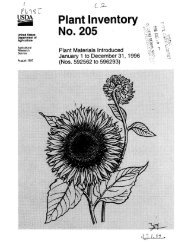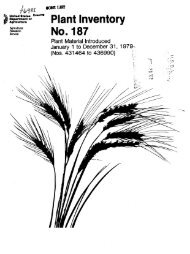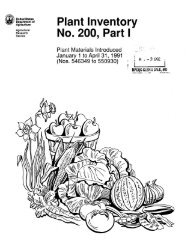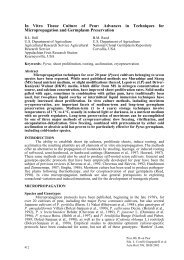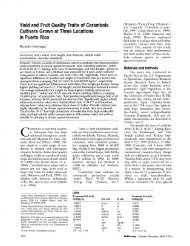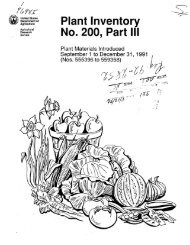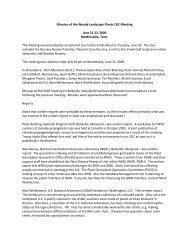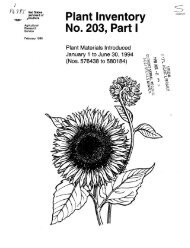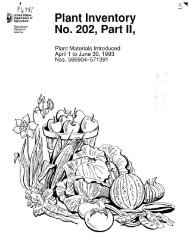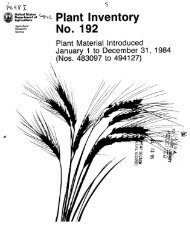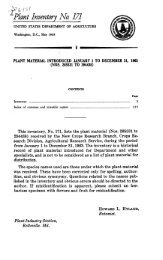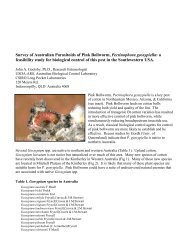Plant Inventory No. 213 - The Germplasm Resources Information ...
Plant Inventory No. 213 - The Germplasm Resources Information ...
Plant Inventory No. 213 - The Germplasm Resources Information ...
- No tags were found...
You also want an ePaper? Increase the reach of your titles
YUMPU automatically turns print PDFs into web optimized ePapers that Google loves.
PI 634747 PVPO. Glycine max (L.) Merr.Cultivar. "91M11". PVP 200400086.PI 634748 PVPO. Glycine max (L.) Merr.Cultivar. "90M60". PVP 200400087.PI 634749 PVPO. Glycine max (L.) Merr.Cultivar. "90M20". PVP 200400088.<strong>The</strong> following were developed by W. James Grichar, Texas A&M University, TexasA&M Agric. Res. Station, P. O. Box 755, Yoakum, Texas 77995, United States;Mark A. Hussey, Texas A&M University, Department of Soil & Crop Sciences,Room 430, Heep Center, College Station, Texas 77843-2474, United States;William R. Ocumpaugh, Texas A&M University, Texas Agricultural Exp. Station,3507 Highway 59 E, Beeville, Texas 78102-9410, United States; Rod L. Reed,Angelo State University, Box 10888, ASU Station, 2601 West Avenue N, SanAngelo, Texas 76909, United States; D.H. Bade, Texas Coop. Ext., CollegeStation, Texas 77843, United States; J.P. Muir, Texas Agricultural ExperimentStation, Stephenville, Texas, United States; M.K. Owens, Texas AgriculturalExperiment Station, Uvalde, Texas 78102, United States; J.L. Reilley, Kika dela Garza PMC, Kingsville, Texas, United States; A.H. Abrameit, Texas Coop.Ext., Thrall, Texas, United States. Donated by Cunningham Laboratory ofCSIRO, St. Lucia, St. Lucia, Queensland, Australia. Received 03/09/2004.PI 634750. Desmanthus bicornutus S. WatsonCultivar. "BeeTAM-06"; CPI 90906. CV-227. Collected in Sinaloa, Mexico.Latitude 24° 35' N. Longitude 107° 52' W. Elevation 2 m. Rainfall zone 650mm. Pedigree - Originated from seed collected in Sinaloa, Mexico. Seedprovided by Cunningham Laboratory of CSIRO in St. Lucia, Queensland,Australia. <strong>No</strong> genetic shift from the original seed. <strong>Plant</strong>s show a highlyelongated hypocotyl and minimally elongated epicotyl at seedling emergence.<strong>Plant</strong> expresses nyctinastic leaf movements with both the pinnae and petiolemoving downward at night. <strong>The</strong> cotyledons as well as the leaflets undergoupward nyctinastic movement. <strong>Plant</strong> is not seismonastic. Although this plantwill flower in the spring, will not flower in the spring of the year ofestablishment. <strong>Plant</strong> height varies with rainfall, but under reasonablemoisture and growing conditions, plant will grow to a height of 1.25 to 2.5meters. <strong>Plant</strong> becomes woody at base as matures, and developes a cylindrical,woody, branched taproot. Begins flowering in late August or early Sept.Flowering and seed set can be greatly modified by drought and heat stress,and if soil or water variation exists within a field, flowering within afield can be modified by several days to more than two weeks. Flowers areround heads or condensed spikes born 1-2 in the axils of the leaves. <strong>Plant</strong>flowers profusely and will set pod in clusters of 11 or 12 pods per cluster.Each pod about 10 to 11 seeds that weigh from 0.350 to 0.570 grams per 100seed. Fruit shape linear; endocarp elaborated into hair-like structuresbetween the seed; and distal end of legume fruit has an attenuated beak.Pods dehiscent along both sutures. Leaf color green to dark green (5 GY 3/4to 7.5 GY 4/4). Stem and pods tend to turn red (5R 3/4) in the fall astemperatures cool down. Immature pods mostly green, but as pod starts tomature turn red on the upper surface. Leaf bipinnately compound with about 7pairs of pinnae per leaf and about 19 pairs of leaflets per pinnae. Petiolelength about 50 to 60 mm and the longest pinnae about 23 to 28 mm. Stipulelength about 3.5 mm. Fully mature seed brown (2.5 YR 3/4).50




